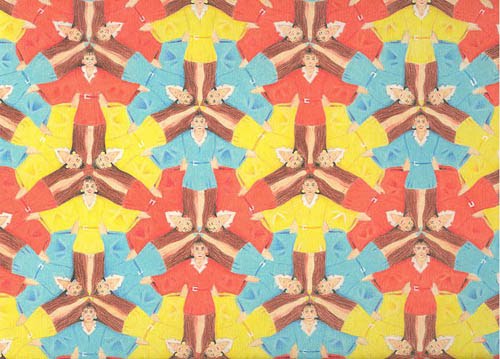Human Numbers
Posted on December 16, 2017
David Bailey on Escher’s tessellations
As this semester comes to an end, I’m left with the same feeling I always had after finishing a project back when I was an entrepreneur; the feeling that, ultimately, no design solution matters.
This feeling is deeply rooted in my despise for relentless human reproduction, and the idea that humanity considers reproduction a right when reproduction itself is a surviving mechanism for passing genetic code, nothing else, and humans long ago ceased to be subject to reproduction in order to guarantee the survival of the species.
Much of what is wrong with the world today can be reduced to numbers. To the number of humans more precisely. But as an intrinsically parasitic society that promotes reproduction as a means for maintaining the status quo, is not surprising that nowadays the most effective tool for birth control in developed countries is money, because what is reproduction but another way of consumption?
Granted, having children have several benefits on an individual and social level, I myself expect to have children at some point, so I’m not abiding for a childless world, but instead for a world that is more conscious of the effects of their reproductive patterns.
This, of course, is nothing new. China’s one-child act was held for nearly 50 years, India has several states enforcing two-children policies, and the Philippines has been dabbling with this concept for the past couple of years. But when these measures are imparted from top to bottom they are always perceived as bad, as an abuse of power or/and a human rights crime.
Furthermore, comprehensive family planning programs have achieved exceptional results in reducing population and improving the overall welfare of the communities intervened. The Matlab region in Bangladesh is a world-known study case that showed extraordinary benefits on an awareness driven approach to birth control, or more recently efforts done throughout Iran and Rwanda. But still, being top to bottom strategies, they became subject to critique and lost momentum.
I wonder then, what role designers can play in forging a more balanced occupation of our planet that raises from the bottom-up?
Most efforts in design are currently focused on exploring how to supply for the 2050 9.7 billion population. Shouldn’t we be putting some effort into spreading awareness that we shouldn’t be reaching the 10 billion mark in the first place?
Considering that most of the added population over the next decades will be spread amongst the poorest nations in the world should be sufficient to shift the attention from designers into looking for ways to regulate population and not sustain population. But is not.
Maybe first we need to depoliticize population growth?